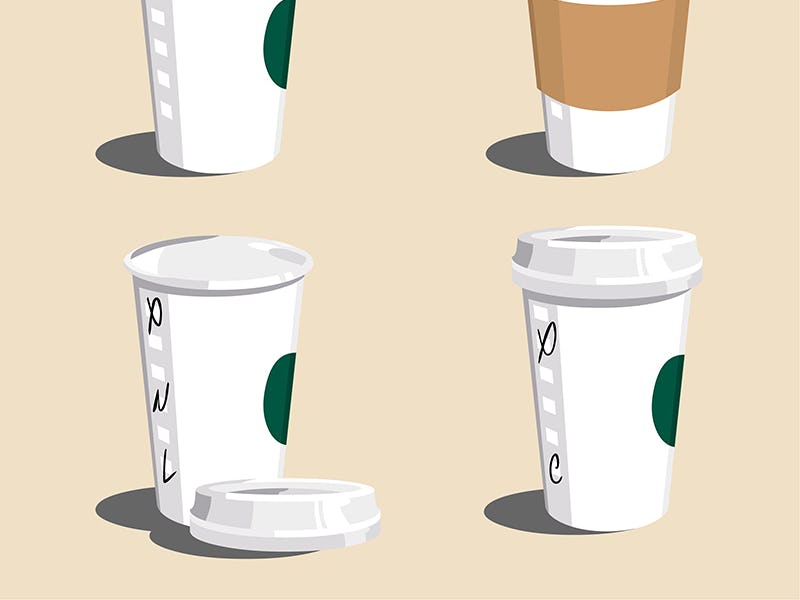Coffee changed your office forever — but not how you'd expect
Our coffee habits aren’t the only thing that changed with Starbucks’ ubiquity.

Before Starbucks went mainstream, coffee had just been a drink that perked you up. Once the Seattle giant became the biggest coffee brand in the world, coffee became an experience. But our coffee habits aren’t the only thing that changed with Starbucks’ ubiquity.
When you visit a Starbucks’ location, there will be at least a few people — typically screenwriters, freelancers, and other creatives — sitting at a table, white paper coffee cup on their side, working on their laptop or phone. This is no accident. Starbucks has actively encouraged customers to use its locations as a “third place” between home and work, “a warm and welcoming environment where customers can gather and connect.”
According to Joshua Zinder, founding principal of JZA+D, an architecture and design firm, this aspect of Starbucks’ design has influenced work campuses across America.
“The notion that you can work everywhere is a response to Starbucks and has had a huge influence on corporate cafes,” he says.
The problem
Before the 1990s, office cafeterias only existed to efficiently feed workers during a dedicated meal break. A 1993 Los Angeles Times article described these cafeterias as having “big steam tables filled with food prepared two hours ago.” Think “rubbery Salisbury steak and lumpy mashed potatoes.” Yum.
A transition had been underway in many corporate cafeterias to serve food that actually competed with what people ate for dinner at restaurants.
“Variety is absolutely essential,” Bob Kaiser, a food service industry consultant, told The New York Times in 1985. “Employees faced with the same menu week in and week out will eventually brown-bag it or go off-site for lunch.”
It seems obvious now, but only the biggest companies, such as Taco Bell and IBM, had been privy to these demands decades ago. Smaller employers would need some inspiration to change their on-campus offerings, and that’s where Starbucks comes in.
The solution
Toward the end of the 2000s, laptops and smartphones were slowly creeping into offices. The flexibility these devices afforded meant that work could be done anywhere, at any time.
“When the millennial generation came into the workforce, they liked the idea that they could work in Starbucks,” Zinder says. “They brought that experience from high school and college into their jobs.”
With open offices becoming the norm, providing flexible workspaces became a priority for companies. That meant people could work at their desks, in meeting rooms or phone booths, on lounge chairs or in cafeterias — and just like Starbucks, all these places needed good wifi. This flexibility not only made people feel more comfortable at work but had the benefit of encouraging people to spend more time in the office, collaborating with their peers, and working later.
“Our corporate clients and their employees expect more from their cafeterias now, and the increased investments have resulted in greater prominence and visibility for these spaces,” says Karen Bala, director of design at Dyer Brown. “They are now frequently located at entry points, often adjacent to lobbies and other kinds of dynamic space. They also more often enjoy views and vistas and lots of natural daylight. They are also spaces for informal collaboration, for “all hands” meetings and social events. They are, at times, the space that binds an office ecosystem together, which is vastly different from how they were designed and perceived just a decade ago.”
The evolution
One trend that has run adjacent to Starbucks has been the farm-to-table movement, and that has also positively changed corporate cafeterias. Companies have realized the benefits of caring for their employees’ health, which has manifested in the form of fresh food and produce being readily available in offices.
“California’s farm-to-table movement and programs for school cafeterias have moved the culture forward by decades, setting the table, so to speak, for experts in design, food, and technology to cooperate effectively,” Bala says.
Companies also have more options when it comes to food providers for their offices. Along with private chefs and hospitality companies, there are also tech-driven operations including Fooda, EAT Club, and Grubhub, which connects companies with local brick-and-mortar restaurants to provide meals for their workers.
“These service companies also shrink or eliminate the requirements for prep areas and back-of-house support zones — and eliminate the need for serveries and kitchens — opening up more space for seating,” Bala says. “They transform an otherwise lifeless lobby or event space into a dynamic, socially activated experience,” much like a Starbucks.
The future
More work campuses will incorporate open and well-lit spaces and offer healthy foods going forward. There will also be an increase in companies “inviting a variety of food and beverage vendors to service a single location, and a shift toward availability of micro-markets and coffee or snack kiosks installed in cafeterias, to capture a 24-hour workforce,” Bala says.
What’s unclear is how concerns about health and safety will impact workplace cafeterias. It’s possible companies may stagger meal times so less people take lunch at the same time and seating can be further spaced out, Zinder says. Another possibility will be internal apps for ordering campus food in advance for pickup or delivery to an employee’s space.
At least there’s one thing people can depend on staying the same: office coffee being good, something Starbucks definitely had a hand in.